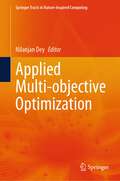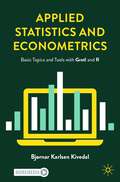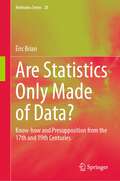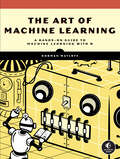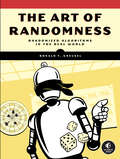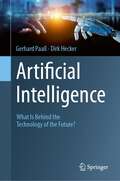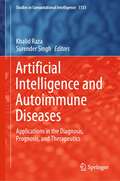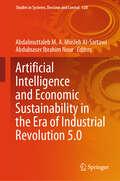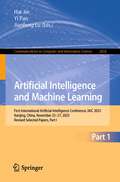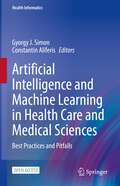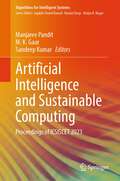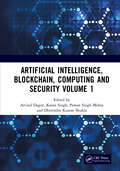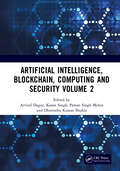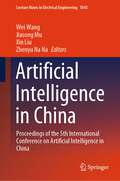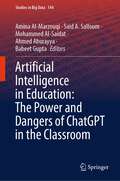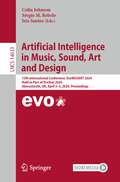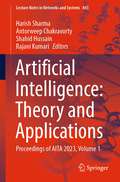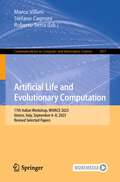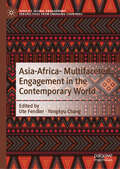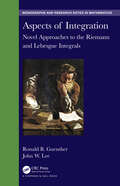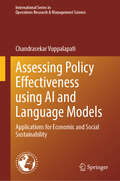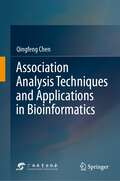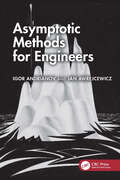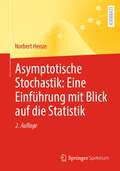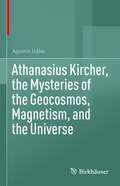- Table View
- List View
Applied Multi-objective Optimization (Springer Tracts in Nature-Inspired Computing)
by Nilanjan DeyThe book explains basic ideas behind several kinds of applied multi-objective optimization and shows how it will be applied in practical contexts in the domain of healthcare, engineering design, and manufacturing. The book discusses how meta-heuristic algorithms are successful in resolving challenging, multi-objective optimization issues in various disciplines, including engineering, economics, medical and environmental management. The topic is useful for graduates, researchers and lecturers in optimization, engineering, management science and computer science.
Applied Statistics and Econometrics: Basic Topics and Tools with Gretl and R
by Bjørnar Karlsen KivedalThis accessible textbook introduces the foundations of applied econometrics and statistics for undergraduate students. It covers key topics in econometrics by using step-by-step examples in Gretl and R, providing a guide to using statistical software and the tools for econometric analysis in one self-contained resource. Taking a concise, non-technical approach, the book covers topics including simple regression and hypothesis testing, multiple regression with control variables and isolating effects, instrumental variables, dummy variables, non-linear effects, probability models, heteroskedasticity, time series analysis, and other applied statistical tools such as t-tests and chi squared tests. The book uses small data sets to easily facilitate students’ transition from manual statistical calculations to using and understanding statistical software, including step-by-step examples of regression analysis, as well as additional chapters to aid with econometric notation and mathematical prerequisites, and accompanying online exercises and data sets. This book will be a valuable resource for upper undergraduate students taking courses in introductory econometrics and statistics, as well as students in business administration and other fields of study in social sciences utilising quantitative methods. Graduate students may also benefit from the book.
Are Statistics Only Made of Data?: Know-how and Presupposition from the 17th and 19th Centuries (Methodos Series #20)
by Éric BrianThis book examines several epistemological regimes in studies of numerical data over the last four centuries. It distinguishes these regimes and mobilises questions present in the philosophy of science, sociology and historical works throughout the 20th century. Attention is given to the skills of scholars and their methods, their assumptions, and the socio-historical conditions that made calculations and their interpretations possible. In doing so, questions posed as early as Émile Durkheim’s and Ernst Cassirer’s ones are revisited and the concept of symbolic form is put to the test in this particular survey, conducted over long period of time. Although distinct from a methodological and epistemological point of view, today these regimes may be found together in the toolbox of statisticians and those who comment on their conclusions. As such, the book is addressed to social scientists and historians and all those who are interested in numerical productions.
The Art of Machine Learning: A Hands-On Guide to Machine Learning with R
by Norman MatloffLearn to expertly apply a range of machine learning methods to real data with this practical guide.Packed with real datasets and practical examples, The Art of Machine Learning will help you develop an intuitive understanding of how and why ML methods work, without the need for advanced math.As you work through the book, you&’ll learn how to implement a range of powerful ML techniques, starting with the k-Nearest Neighbors (k-NN) method and random forests, and moving on to gradient boosting, support vector machines (SVMs), neural networks, and more.With the aid of real datasets, you&’ll delve into regression models through the use of a bike-sharing dataset, explore decision trees by leveraging New York City taxi data, and dissect parametric methods with baseball player stats. You&’ll also find expert tips for avoiding common problems, like handling &“dirty&” or unbalanced data, and how to troubleshoot pitfalls.You&’ll also explore:How to deal with large datasets and techniques for dimension reductionDetails on how the Bias-Variance Trade-off plays out in specific ML methodsModels based on linear relationships, including ridge and LASSO regressionReal-world image and text classification and how to handle time series dataMachine learning is an art that requires careful tuning and tweaking. With The Art of Machine Learning as your guide, you&’ll master the underlying principles of ML that will empower you to effectively use these models, rather than simply provide a few stock actions with limited practical use.Requirements: A basic understanding of graphs and charts and familiarity with the R programming language
The Art of Randomness: Randomized Algorithms in the Real World
by Ronald T. KneuselHarness the power of randomness (and Python code) to solve real-world problems in fun, hands-on experiments—from simulating evolution to encrypting messages to making machine-learning algorithms!The Art of Randomness is a hands-on guide to mastering the many ways you can use randomized algorithms to solve real programming and scientific problems. You&’ll learn how to use randomness to run simulations, hide information, design experiments, and even create art and music. All you need is some Python, basic high school math, and a roll of the dice.Author Ronald T. Kneusel focuses on helping you build your intuition so that you&’ll know when and how to use random processes to get things done. You&’ll develop a randomness engine (a Python class that supplies random values from your chosen source), then explore how to leverage randomness to:Simulate Darwinian evolution and optimize with swarm-based search algorithmsDesign scientific experiments to produce more meaningful results by making them truly randomImplement machine learning algorithms like neural networks and random forestsUse Markov Chain Monte Carlo methods to sample from complex distributionsHide information in audio files and images, generate art, and create musicReconstruct original signals and images from only randomly sampled dataScientific anecdotes and code examples throughout illustrate how randomness plays into areas like optimization, machine learning, and audio signals. End-of-chapter exercises encourage further exploration.Whether you&’re a programmer, scientist, engineer, mathematician, or artist, you&’ll find The Art of Randomness to be your ticket to discovering the hidden power of applied randomness and the ways it can transform your approach to solving problems, from the technical to the artistic.
Artificial Intelligence: What Is Behind the Technology of the Future?
by Gerhard Paaß Dirk HeckerArtificial Intelligence (AI) is already present in our daily routines, and in the future, we will encounter it in almost every aspect of life – from analyzing X-rays for medical diagnosis, driving autonomous cars, maintaining complex machinery, to drafting essays on environmental problems and drawing imaginative pictures. The potentials of AI are enormous, while at the same time many myths, uncertainties and challenges circulate that need to be tackled. The English translation of the book “Künstliche Intelligenz – Was steckt hinter der Technologie der Zukunft?” originally published in German (Springer Vieweg, 2020), this book is addressed to the general public, from interested citizens to corporate executives who want to develop a better and deeper understanding of AI technologies and assess their consequences. Mathematical basics, terminology, and methods are explained in understandable language. Adaptations to different media such as images, text, and speech and the corresponding generative models are introduced. A concluding discussion of opportunities and challenges helps readers evaluate new developments, demystify them, and assess their relevance for the future.
Artificial Intelligence and Autoimmune Diseases: Applications in the Diagnosis, Prognosis, and Therapeutics (Studies in Computational Intelligence #1133)
by Khalid Raza Surender SinghThe book provides an overview of various autoimmune disorders and how artificial intelligence (AI) and machine learning will be used for the diagnosis, prognosis, and treatment of these disorders. AI algorithms are used to create synthetic patient populations with the properties of actual patient cohorts, build personalized predictive models of drug combinations and unravel complex relationships between diet, microbiome, and genetic line-up to determine the comparative treatment response. The book highlights clinical applications and challenges of AI for the diagnosis and treatment/management of autoimmune disorders which includes Rheumatoid Arthritis (RA), Multiple Sclerosis (MS), Type I Diabetes, Psoriatic Arthritis (PsA), and other critical diseases.
Artificial Intelligence and Economic Sustainability in the Era of Industrial Revolution 5.0 (Studies in Systems, Decision and Control #528)
by Abdalmuttaleb M. A. Musleh Al-Sartawi Abdulnaser Ibrahim NourIndustry 5.0 has been dubbed as the digital revolution with a soul. This book incorporates a wealth of research which integrates artificial intelligence (AI) with economic sustainability and Industry 5.0. It examines the human-centricity of the upcoming digital revolution and the role of sustainable technologies in enhancing the livelihoods of workers, individuals, communities, and eventually societies. It provides insight on important areas related to artificial intelligence, sustainable development, and society 5.0. The chapters present a wide range of topics including block cipher, entrepreneurship and AI, AI and stock trading decisions, digital transformation, knowledge management, chatbot engineering, cybersecurity, and smart metering system. This book is beneficial to scholars and academics who will find in it the knowledge of the support of AI and its contribution to economic sustainability, and solutions to enhance human-centricity and resilience.
Artificial Intelligence and Machine Learning: First International Artificial Intelligence Conference, IAIC 2023, Nanjing, China, November 25–27, 2023, Revised Selected Papers, Part I (Communications in Computer and Information Science #2058)
by Hai Jin Yi Pan Jianfeng LuThis 3-volume set, CCIS 2058-2060 constitutes the First International Conference, on Artificial Intelligence, IAIC 2023, held in Nanjing, China, in November 2023. The 85 full papers presented were carefully reviewed and selected from 428 submissions. The papers are clustered in parts on: Artificial Intelligence and Machine Learning; Data Security and information Security; Computer Networks and IoT. The papers present recent research and developments in artificial intelligence and its applications in machine learning, natural language processing, computer vision, robotics, and ethical considerations.
Artificial Intelligence and Machine Learning in Health Care and Medical Sciences: Best Practices and Pitfalls (Health Informatics)
by Gyorgy J. Simon Constantin AliferisThis open access book provides a detailed review of the latest methods and applications of artificial intelligence (AI) and machine learning (ML) in medicine. With chapters focusing on enabling the reader to develop a thorough understanding of the key concepts in these subject areas along with a range of methods and resulting models that can be utilized to solve healthcare problems, the use of causal and predictive models are comprehensively discussed. Care is taken to systematically describe the concepts to facilitate the reader in developing a thorough conceptual understanding of how different methods and resulting models function and how these relate to their applicability to various issues in health care and medical sciences. Guidance is also given on how to avoid pitfalls that can be encountered on a day-to-day basis and stratify potential clinical risks. Artificial Intelligence and Machine Learning in Health Care and Medical Sciences: Best Practices and Pitfallsis a comprehensive guide to how AI and ML techniques can best be applied in health care. The emphasis placed on how to avoid a variety of pitfalls that can be encountered makes it an indispensable guide for all medical informatics professionals and physicians who utilize these methodologies on a day-to-day basis. Furthermore, this work will be of significant interest to health data scientists, administrators and to students in the health sciences seeking an up-to-date resource on the topic.
Artificial Intelligence and Sustainable Computing: Proceedings of ICSISCET 2023 (Algorithms for Intelligent Systems)
by Sandeep Kumar Manjaree Pandit M. K. GaurThis book presents high-quality research papers presented at the 5th International Conference on Sustainable and Innovative Solutions for Current Challenges in Engineering and Technology (ICSISCET 2023) held at Madhav Institute of Technology & Science (MITS), Gwalior, India, during October 21–22, 2023. The book extensively covers recent research in artificial intelligence (AI) that knit together nature-inspired algorithms, evolutionary computing, fuzzy systems, computational intelligence, machine learning, deep learning, etc., which is very useful while dealing with real problems due to their model-free structure, learning ability, and flexible approach. These techniques mimic human thinking and decision-making abilities to produce systems that are intelligent, efficient, cost-effective, and fast. The book provides a friendly and informative treatment of the topics which makes this book an ideal reference for both beginners and experienced researchers.
Artificial Intelligence, Blockchain, Computing and Security Volume 1: Proceedings of the International Conference on Artificial Intelligence, Blockchain, Computing and Security (ICABCS 2023), Gr. Noida, UP, India, 24 - 25 February 2023
by Arvind Dagur Karan Singh Pawan Singh Mehra Dhirendra Kumar ShuklaThis book contains the conference proceedings of ICABCS 2023, a non-profit conference with the objective to provide a platform that allows academicians, researchers, scholars and students from various institutions, universities and industries in India and abroad to exchange their research and innovative ideas in the field of Artificial Intelligence, Blockchain, Computing and Security. It explores the recent advancement in field of Artificial Intelligence, Blockchain, Communication and Security in this digital era for novice to profound knowledge about cutting edges in artificial intelligence, financial, secure transaction, monitoring, real time assistance and security for advanced stage learners/ researchers/ academicians. The key features of this book are: Broad knowledge and research trends in artificial intelligence and blockchain with security and their role in smart living assistance Depiction of system model and architecture for clear picture of AI in real life Discussion on the role of Artificial Intelligence and Blockchain in various real-life problems across sectors including banking, healthcare, navigation, communication, security Explanation of the challenges and opportunities in AI and Blockchain based healthcare, education, banking, and related industries This book will be of great interest to researchers, academicians, undergraduate students, postgraduate students, research scholars, industry professionals, technologists, and entrepreneurs.
Artificial Intelligence, Blockchain, Computing and Security Volume 2: Proceedings of the International Conference on Artificial Intelligence, Blockchain, Computing and Security (ICABCS 2023), Gr. Noida, UP, India, 24 - 25 February 2023
by Arvind Dagur Karan Singh Pawan Singh Mehra Dhirendra Kumar ShuklaThis book contains the conference proceedings of ICABCS 2023, a non-profit conference with the objective to provide a platform that allows academicians, researchers, scholars and students from various institutions, universities and industries in India and abroad to exchange their research and innovative ideas in the field of Artificial Intelligence, Blockchain, Computing and Security. It explores the recent advancement in field of Artificial Intelligence, Blockchain, Communication and Security in this digital era for novice to profound knowledge about cutting edges in artificial intelligence, financial, secure transaction, monitoring, real time assistance and security for advanced stage learners/ researchers/ academicians. The key features of this book are: Broad knowledge and research trends in artificial intelligence and blockchain with security and their role in smart living assistance Depiction of system model and architecture for clear picture of AI in real life Discussion on the role of Artificial Intelligence and Blockchain in various real-life problems across sectors including banking, healthcare, navigation, communication, security Explanation of the challenges and opportunities in AI and Blockchain based healthcare, education, banking, and related industries This book will be of great interest to researchers, academicians, undergraduate students, postgraduate students, research scholars, industry professionals, technologists, and entrepreneurs.
Artificial Intelligence in China: Proceedings of the 5th International Conference on Artificial Intelligence in China (Lecture Notes in Electrical Engineering #1043)
by Wei Wang Jiasong Mu Xin Liu Zhenyu Na NaThis book brings together papers presented at the 2023 The International Conference on Artificial Intelligence in China (ChinaAI), which provides a venue to disseminate the latest developments and to discuss the interactions and links between these multidisciplinary fields. Spanning topics covering all topics in Artificial Intelligence with new development in China, this book is aimed at undergraduate and graduate students in Electrical Engineering, Computer Science and Mathematics, researchers and engineers from academia and industry as well as government employees (such as NSF, DOD, DOE).
Artificial Intelligence in Education: The Power and Dangers of ChatGPT in the Classroom (Studies in Big Data #144)
by Amina Al-Marzouqi Said A. Salloum Mohammed Al-Saidat Ahmed Aburayya Babeet GuptaThis book aims to bring together a collection of innovative and cutting-edge research that addresses the various challenges in the application and theoretical aspects of ChatGPT in education. ChatGPT is a large language model developed by OpenAI that has the ability to generate human-like text based on a prompt. This has significant potential for use in the field of education, as it allows for the creation of personalized, interactive learning experiences, automating assessment and grading, and more. In e-learning, ChatGPT is used to provide instant feedback and support to students, as well as generate interactive conversations in the target language for language learning. It is also integrated with existing learning management systems and educational technology platforms to enhance their capabilities. In research, ChatGPT is used for natural language processing and sentiment analysis to gather insights on student learning experiences and educational outcomes. However, it is important to note that there are also ethical and privacy concerns that come with using language models like ChatGPT in education, such as data protection and the potential for bias. Overall, the use of ChatGPT in education has the potential to revolutionize the way we learn, teach, and access information. The book seeks to publish original manuscripts that cover a broad range of topics, from the development of new chatbot technologies and their integration into the classroom, to the examination of the ethical and pedagogical implications of these systems. By compiling the latest developments in the field and highlighting new areas for exploration, this book provides valuable insights and perspectives for researchers, educators, and practitioners working in the field of ChatGPT and education. The ultimate goal is to advance the understanding of ChatGPT and its role in education and to promote its effective and responsible use in the classroom and beyond.
Artificial Intelligence in Music, Sound, Art and Design: 13th International Conference, EvoMUSART 2024, Held as Part of EvoStar 2024, Aberystwyth, UK, April 3–5, 2024, Proceedings (Lecture Notes in Computer Science #14633)
by Colin Johnson Sérgio M. Rebelo Iria SantosThis book constitutes the refereed proceedings of the 13th International Conference on Artificial Intelligence in Music, Sound, Art and Design, EvoMUSART 2024, held as part of EvoStar 2024, in Aberystwyth, UK, April 3–5, 2024. The 17 full papers and 8 short papers presented in this book were carefully reviewed and selected from 55 submissions. The main purpose of this conference proceedings was to bring together practitioners who are using Artificial Intelligence techniques for artistic tasks, providing the opportunity to promote, present, and discuss ongoing work in the area.
Artificial Intelligence: Proceedings of AITA 2023, Volume 1 (Lecture Notes in Networks and Systems #843)
by Harish Sharma Antorweep Chakravorty Shahid Hussain Rajani KumariThis book features a collection of high-quality research papers presented at International Conference on Artificial Intelligence: Theory and Applications (AITA 2023), held during 11–12 August 2023 in Bengaluru, India. The book is divided into two volumes and presents original research and review papers related to artificial intelligence and its applications in various domains including health care, finance, transportation, education, and many more.
Artificial Life and Evolutionary Computation: 17th Italian Workshop, WIVACE 2023, Venice, Italy, September 6–8, 2023, Revised Selected Papers (Communications in Computer and Information Science #1977)
by Marco Villani Stefano Cagnoni Roberto SerraThis book constitutes the refereed post proceedings of the 17th Italian Workshop on Artificial Life and Evolutionary Computation, WIVACE 2023, held in Venice, Italy, during September 6–8, 2023.The 30 full papers included in this book were carefully reviewed and selected from 55 submissions. They were organized in topical sections as follows: Algorithms for complex systems, Biologically inspired models, Complex chemical systems, Adaptation and swarms, Learning, Medicine and Social systems.
Asia-Afria- Multifaceted Engagement in the Contemporary World (Africa's Global Engagement: Perspectives from Emerging Countries)
by Yongkyu Chang Ute FendlerThis book provides an insight into the complex entanglements between African countries and India, China, and South Korea from multidisciplinary perspectives connecting approaches from cultural, anthropological, literary, and music studies and art history. The three parts present a regional focus, namely Africa-India, Africa-South Korea, and Africa-China while the single contributions speak to each other and offer complementary insights. At the same time, the chapters also link across the regional realms as they deal with similar topics, such as travelling music genres. In part I, for Pombo material culture is the starting point to investigate the connections between the islands of the Indian Ocean and India by questioning the construction of memory. It highlights various aspects of the multilayered history of connections between Africa, the islands, and India. Part II gathers contributions that are complimentary to each other and therefore contribute to the understanding of the complex entanglements in area studies. Part III (Africa-South Korea) explores the impact of African-American arts and artists on South Korea's popular culture as well as the changing perception of artists of African descent in visual popular culture. It shows the impact of Korean content in South Africa.
Aspects of Integration: Novel Approaches to the Riemann and Lebesgue Integrals (Chapman & Hall/CRC Monographs and Research Notes in Mathematics)
by Ronald B. Guenther John W. LeeAspects of Integration: Novel Approaches to the Riemann and Lebesgue Integrals is comprised of two parts. The first part is devoted to the Riemann integral, and provides not only a novel approach, but also includes several neat examples that are rarely found in other treatments of Riemann integration. Historical remarks trace the development of integration from the method of exhaustion of Eudoxus and Archimedes, used to evaluate areas related to circles and parabolas, to Riemann’s careful definition of the definite integral, which is a powerful expansion of the method of exhaustion and makes it clear what a definite integral really is.The second part follows the approach of Riesz and Nagy in which the Lebesgue integral is developed without the need for any measure theory. Our approach is novel in part because it uses integrals of continuous functions rather than integrals of step functions as its starting point. This is natural because Riemann integrals of continuous functions occur much more frequently than do integrals of step functions as a precursor to Lebesgue integration. In addition, the approach used here is natural because step functions play no role in the novel development of the Riemann integral in the first part of the book. Our presentation of the Riesz-Nagy approach is significantly more accessible, especially in its discussion of the two key lemmas upon which the approach critically depends, and is more concise than other treatments.Features Presents novel approaches designed to be more accessible than classical presentations A welcome alternative approach to the Riemann integral in undergraduate analysis courses Makes the Lebesgue integral accessible to upper division undergraduate students How completion of the Riemann integral leads to the Lebesgue integral Contains a number of historical insights Gives added perspective to researchers and postgraduates interested in the Riemann and Lebesgue integrals
Assessing Policy Effectiveness using AI and Language Models: Applications for Economic and Social Sustainability (International Series in Operations Research & Management Science #354)
by Chandrasekar VuppalapatiThis volume uses advanced machine learning techniques to analyze government communication to evaluate policy effectiveness. The book develops policy effectiveness foundation models by cohorting historical budget policies with statistical models which are built on well reputed data sources including economic events, macroeconomic trends, and ratings and commerce terms from international institutions. By signal mining policies to the economic outcome patterns, the book aims to create a rich source of successful policy insights in terms of their effectiveness in bringing development to the poor and underserved communities to ensure the spread of wealth, social wellbeing, and standard of living to the common denomination of society rather than a selected quotient. Enabling academics and practitioners across disciplines to develop applications for effective policy interventions, this volume will be of interest to a wide audience including software engineers, data scientists, social scientists, economists, and agriculture practitioners.
Association Analysis Techniques and Applications in Bioinformatics
by Qingfeng ChenAdvances in experimental technologies have given rise to tremendous amounts of biology data. This not only offers valuable sources of data to help understand biological evolution and functional mechanisms, but also poses challenges for accurate and effective data analysis. This book offers an essential introduction to the theoretical and practical aspects of association analysis, including data pre-processing, data mining methods/algorithms, and tools that are widely applied for computational biology. It covers significant recent advances in the field, both foundational and application-oriented, helping readers understand the basic principles and emerging techniques used to discover interesting association patterns in diverse and heterogeneous biology data, such as structure-function correlations, and complex networks with gene/protein regulation. The main results and approaches are described in an easy-to-follow way and accompanied by sufficientreferences and suggestions for future research. This carefully edited monograph is intended to provide investigators in the fields of data mining, machine learning, artificial intelligence, and bioinformatics with a profound guide to the role of association analysis in computational biology. It is also very useful as a general source of information on association analysis, and as an overall accompanying course book and self-study material for graduate students and researchers in both computer science and bioinformatics.
Asymptotic Methods for Engineers
by Igor V. Andrianov Jan AwrejcewiczAsymptotic Methods for Engineers is based on the authors’ many years of practical experience in the application of asymptotic methods to solve engineering problems.This book is devoted to modern asymptotic methods (AM), which is widely used in engineering, applied sciences, physics, and applied mathematics. Avoiding complex formal calculations and justifications, the book’s main goal is to describe the main ideas and algorithms. Moreover, not only is there a presentation of the main AM, but there is also a focus on demonstrating their unity and inseparable connection with the methods of summation and asymptotic interpolation.The book will be useful for students and researchers from applied mathematics and physics and of interest to doctoral and graduate students, university and industry professors from various branches of engineering (mechanical, civil, electro-mechanical, etc.).
Asymptotische Stochastik: Eine Einführung mit Blick auf die Statistik
by Norbert HenzeDieses Lehrbuch liefert einen verständnisorientierten Einstieg in die asymptotische Stochastik. Es ist vom Niveau her zu Beginn eines Mathematik-Masterstudiums angesiedelt und deckt den Stoff ab, der in einer vierstündigen Vorlesung mit zweistündigen Übungen vermittelt werden kann. Einzelne Kapitel eignen sich zudem für Seminare am Ende eines Bachelorstudiums.Neben eher grundständigen Themen wie der Momentenmethode zum Nachweis von Verteilungskonvergenz oder dem multivariaten zentralen Grenzwertsatz und der Delta-Methode werden unter anderem Grenzwertsätze für U-Statistiken und der Satz von Donsker sowie die Brown'sche Brücke mit Anwendungen auf die Statistik behandelt. Das Buch schließt mit einem zentralen Grenzwertsatz für hilbertraumwertige Zufallselemente mit Anwendungen auf gewichtete L²-Statistiken. Ein besonderes Merkmal des Buches sind mehr als 130 Selbstfragen, die am Ende des jeweiligen Kapitels beantwortet werden, sowie mehr als 180 Übungsaufgaben mit Lösungen. Hierdurch eignet sich dieses Werk sehr gut zum Selbststudium.Die 2. Auflage ist vollständig durchgesehen und thematisch unter anderem um die starke Konsistenz der Maximum-Likelihood-Schätzung sowie zentrale Grenzwertsätze für Dreiecksschemata von Zufallsvektoren und hilbertraumwertigen Zufallsvariablen erweitert. Hinzugekommen sind auch weitere Beispiele sowie 11 neue Aufgaben mit Lösungen.
Athanasius Kircher, the Mysteries of the Geocosmos, Magnetism, and the Universe
by Agustín UdíasAthanasius Kircher, the eminent 17th-century German Jesuit professor of mathematics at the Roman College emerges as a captivating figure within the pages of this monograph by Agustín Udías. Aptly deemed 'the man who knew everything,' Kircher's thirty-two comprehensive works, spanning an array of subjects, provide a unique lens into his visionary perspectives. This book delves into three selected works where Kircher unveils his conceptualization of the Earth, termed the 'Geocosmos,' treated magnetism as a cosmic and spiritual force, and embarks on a cosmic exploration from Earth to the stars. From his groundbreaking speculations on the Earth's interior, attributing earthquakes and volcanoes to intricate channels of air, water, and fire, to his cosmic journey accompanied by the ethereal spirit Cosmiel, Kircher's enduring allure persists. Despite variance from contemporary knowledge, situated at the beginning of modern science, Kircher's proposals of the structure of the Earth’s interior, cosmic magnetic theories, and space journey to the stars offer a compelling glimpse into the intellectual landscape of a bygone era, making this book an essential exploration for scholars seeking a nuanced understanding of Kircher's profound influence.
